Last week, Lexus invited me to Portland, Oregon, where I was able to test drive the fourth-generation Lexus RX in all its various forms. The following is a technical overview of the new model — my personal impressions will be posted next week.
Without question, the RX crossover is the most important vehicle in the Lexus lineup. It created a brand new automotive segment with the launch of the first-generation RX in 1998, and as a result the mid-size luxury crossover is one of the most popular vehicle classes in the industry.
The numbers are just staggering — the RX is one of two models in the luxury market to sell over 100,000 per year in the United States, and over 2.1 million units have been sold worldwide over its sixteen year history.
This creates quite a situation for the next-generation RX, which debuted at this year’s New York Auto Show and has just been driven for the first time by the global automotive media. Not only must Lexus satisfy the core customers who upgrade their RX every few years, the engineers and designers must also apply the more aggressive (and controversial) spindle grille design language all while pushing the features and technologies forward.
Let’s dive deep into the new fourth-generation RX, starting with the exterior design.
Exterior
The core theme for the exterior design of the new RX is “Seductive Strength”, and the result is a fusing of the traditional RX shape with sharp lines and a more athletic stance. Here are two early sketches as a starting point:
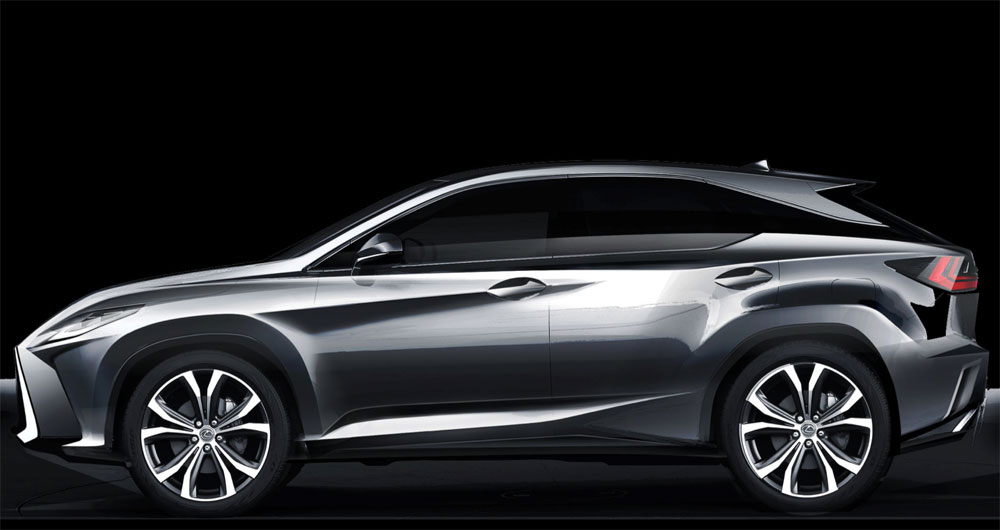
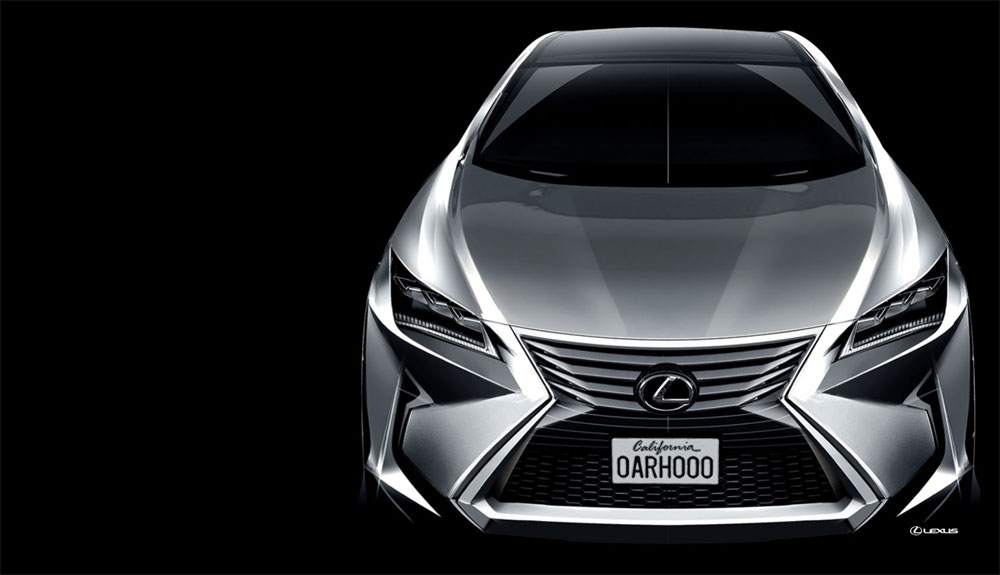
With the front design of the production model, the spindle grille is fully represented. The grille has a higher pinch point than other Lexus models, and the bars mesh well with the body lines:
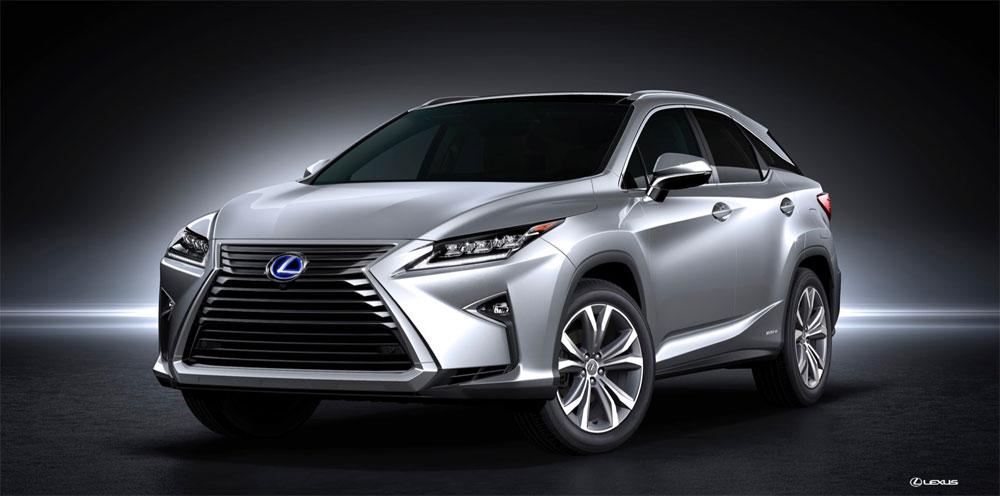
The signature design element of the side profile is the glass connecting the rear passenger window with the back of the vehicle, creating a “floating roof”:
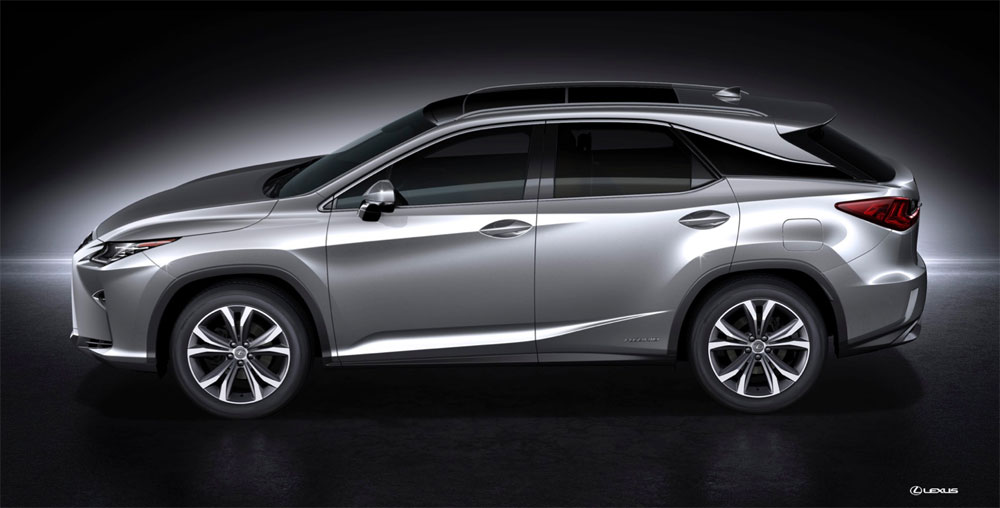
The spindle grille shape makes a muted appearance in the rear door, with the angles of the front hood wrapping around and connecting with the taillights:
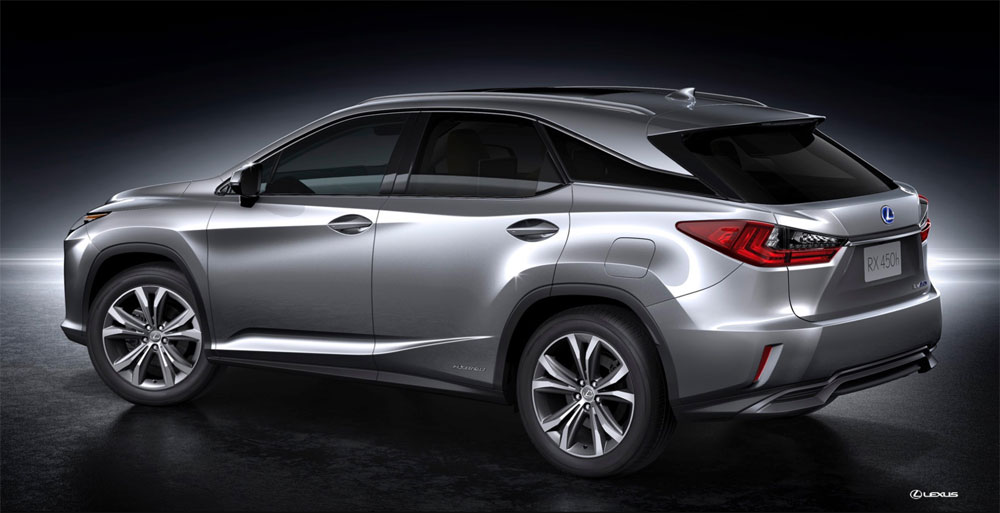
Dimensions
The RX has grown 4.7 inches (120mm) longer to 192.5 inches (4,890mm) in total. As a result, the wheelbase is now up to 109.80 inches (2,790mm), 1.9 inches (50mm) longer.
The width of the new RX has increased just 0.4 inches (10mm) wider than the current model, and height stays the same at 67.7 inches (1,690mm).
Here are two graphics to illustrate the changes — the first image with the vehicle’s new dimensions, the second image comparing it to the outgoing model:
Inside, the RX has also grown larger — front and rear headroom is now at 39.4/39.1 inches (1,005.5/993mm), up 0.3/0.4 inches respectively. Legroom is now at 44.1/38.0 inches (1,120.5/964.5mm) front/back:
The RX 350 has 18.4 cubic feet of cargo space with the rear seats up, and 55.9 cubic feet with the rear seats down — this is approximately 25 cubic feet less than the current RX.
The RX 450h has similar numbers, with 18.0 cubic feet of cargo space with the rear seats up, and 56.3 cubic feet with the rear seats down. Again, this is about 25 cubic feet less than the outgoing model.
(The reason for this reduction in cargo space is due to a change in the methods for measuring volume, Lexus claims there’s more useable space than the current model.)
Body Structure
The body structure of the RX has been upgraded to improve overall rigidity, and uses hot stamp and high tensile steel for a lighter and stronger frame:

The new RX also benefits from rigidity advancements made since the introduction of the last model, starting with the use of body adhesive bonding:
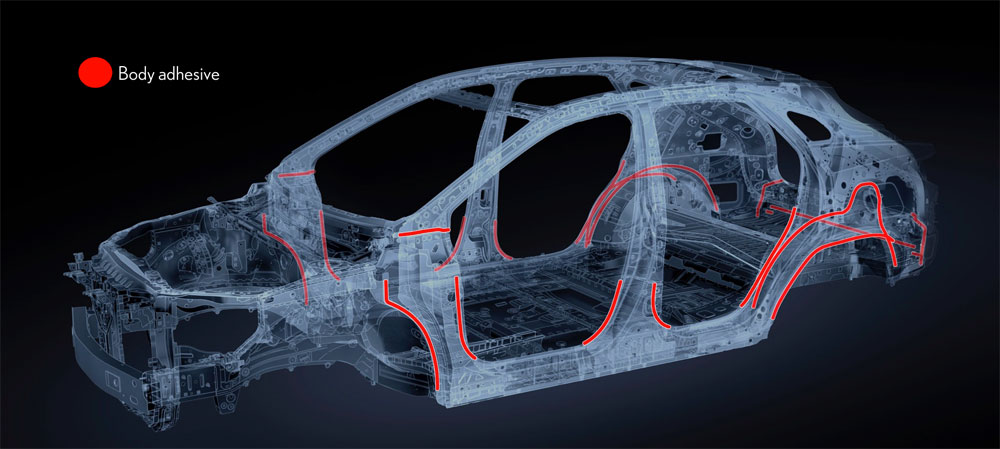
Laser screw welding has also been used around the door openings and between existing spot welds to reduce body flex:
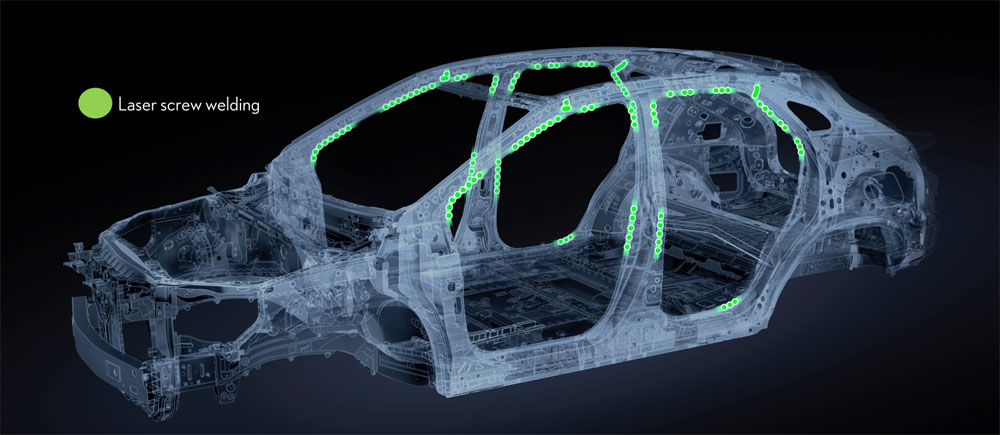
The rear door hatch has also been reinforced with additional spot welds:
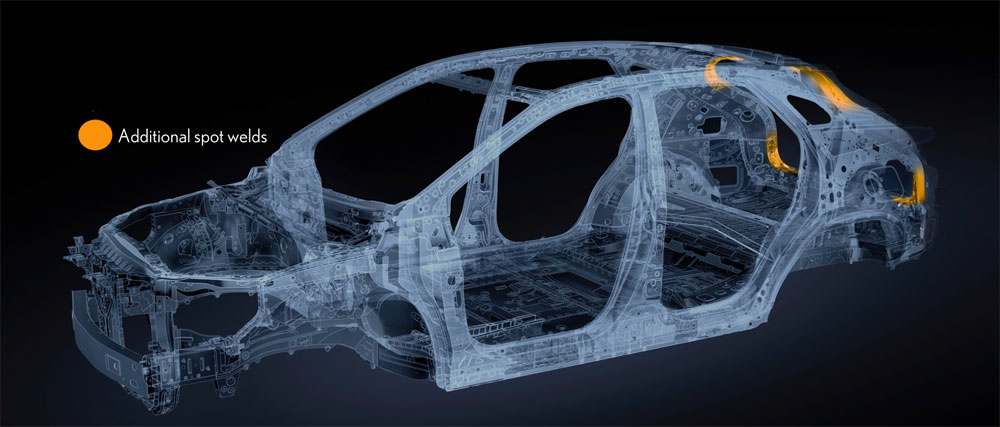
Aluminum has been used for the RX hood and rear door, which has helps to reduce weight and lower the center of gravity. It’s also worth pointing out all the sound absorbing and insulating materials:
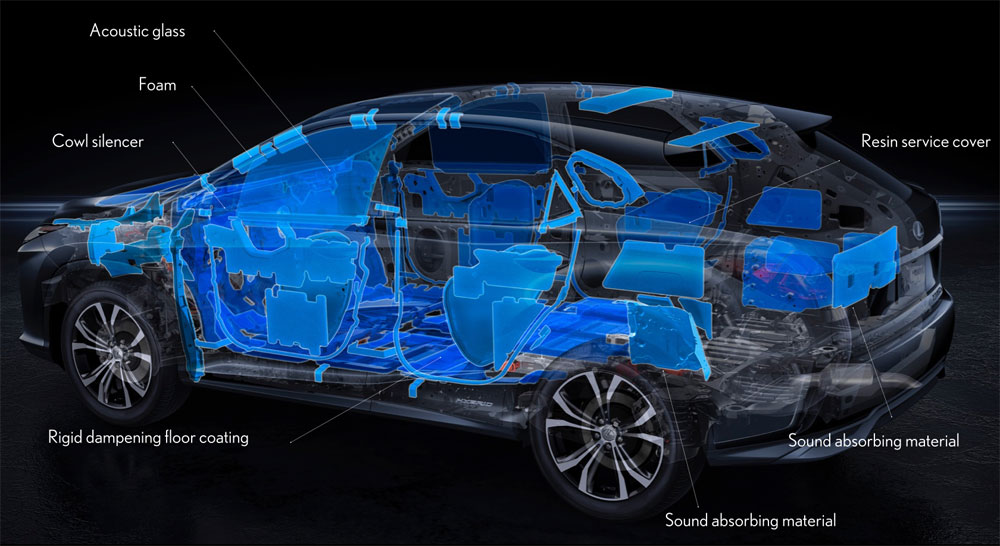
There are a number of aerodynamic enhancements on the RX, including a lower front bumper, underbody covers, and a number of rear adjustments:
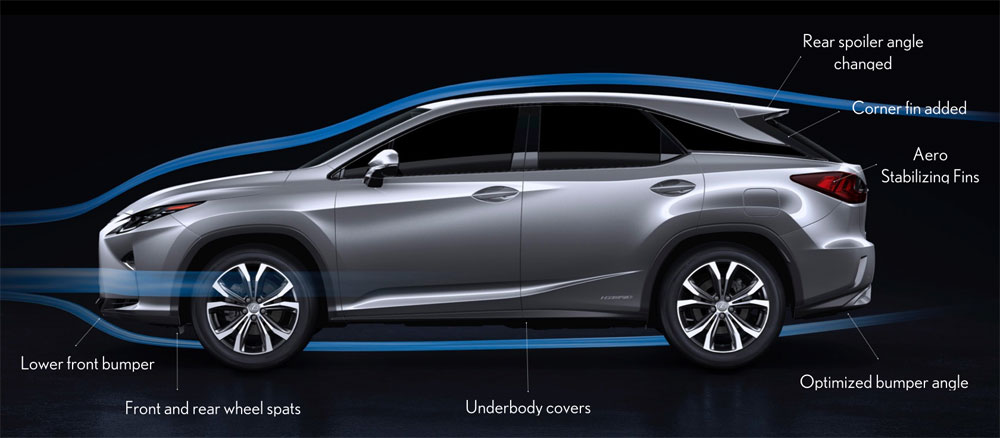
Platform and Chassis
The big improvement to the RX platform are the revamped front engine mounts, which have been relocated to the sub-frame structure for a tighter, more rigid fit. This change increases overall rigidity and reduces body roll, along with minimizing engine vibration.
The RX continues to use a MacPherson front-strut and rear double-wishbone suspension system. Brakes are the standard 4-wheel disc setup — the front brakes remain 12.9-inch ventilated rotors with a two-piston floating caliper, but the rear brakes have grown to 13.3-inch rotors.
Lighting
There are two lighting levels available with the 2016 RX — standard are Bi-LED headlamps, which switch between low and high beams using a single projector. L-shaped LED daytime running lights are also standard.

The standard taillamps are LED as well, and feature a double L-shape that wraps around to the rear fender:

The optional triple-beam LED headlamps are the same seen on the NX & RC:
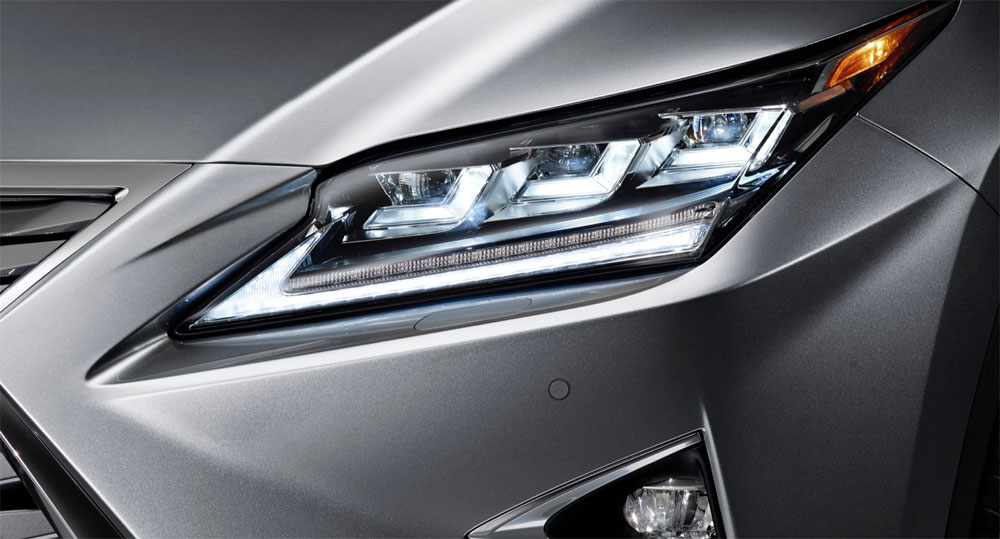
Wide-angle cornering lamps are also the triple-beam LED headlamps, which provide additional brightness when turning:

The premium taillamps are essentially the same as the base design, with one change — the stop lamp is also LED:
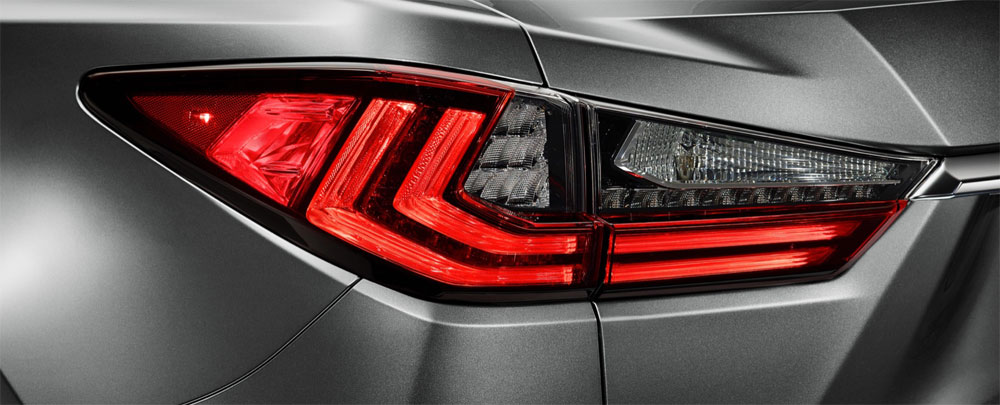
RX 350 Powertrain
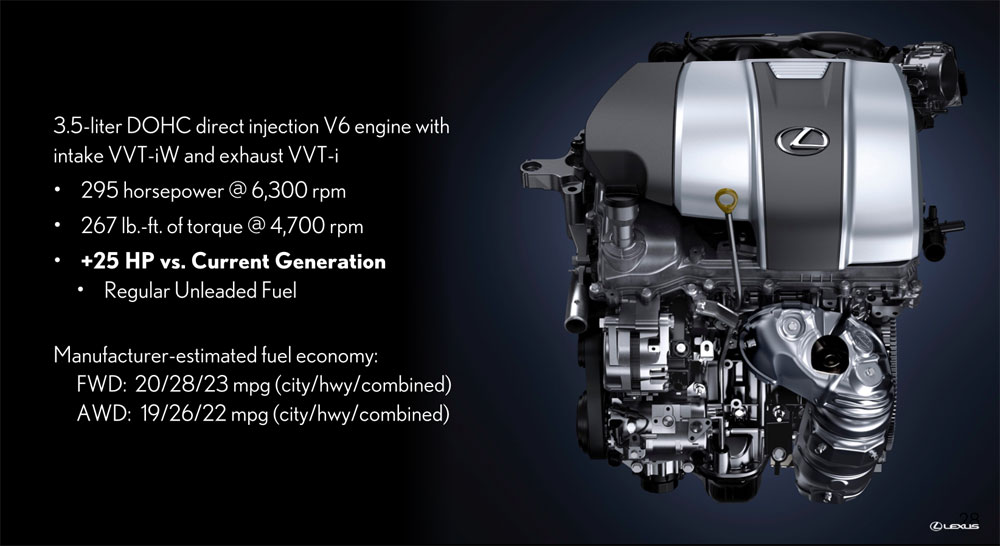
The RX 350 is now powered by the 2GS-FKS 3.5-liter V6 engine with a D-4S fuel injection system and Variable Valve Timing with intelligence Wide (VVT-iW), which enables a dual Atkinson/Otto cycle that balances fuel economy with performance based on driving conditions.
The result of these improvements is a minor power boost, bringing the RX 350 up to 295 horsepower and 267 lb.-ft torque from 270 horsepower and 248 lb.-ft torque. That said, the 0-60 time remains 7.7 seconds for the FWD model and 7.9 seconds for the AWD. Fuel economy has jumped to 20/28/23 city/highway/combined, up from the 18/25/21 rating of the outgoing model.
Paired with the 2GS-FKS V6 is an eight-speed transmission, which has been configured with a lower first gear ( 19-percent lower ratio than second gear) for stronger acceleration from a stop and a higher eighth gear ( 15-percent higher ratio than seventh gear) for improved fuel efficiency.
Dynamic Torque Control has been added to the RX 350 AWD model, which uses multiple vehicle sensors to immediately send power to the rear wheels only when necessary. Torque can be distributed from a range of 100:0 (pure front-wheel drive) to 50:50, balancing out the capability of the AWD system with the fuel efficiency of a FWD model.
RX 450h Powertrain
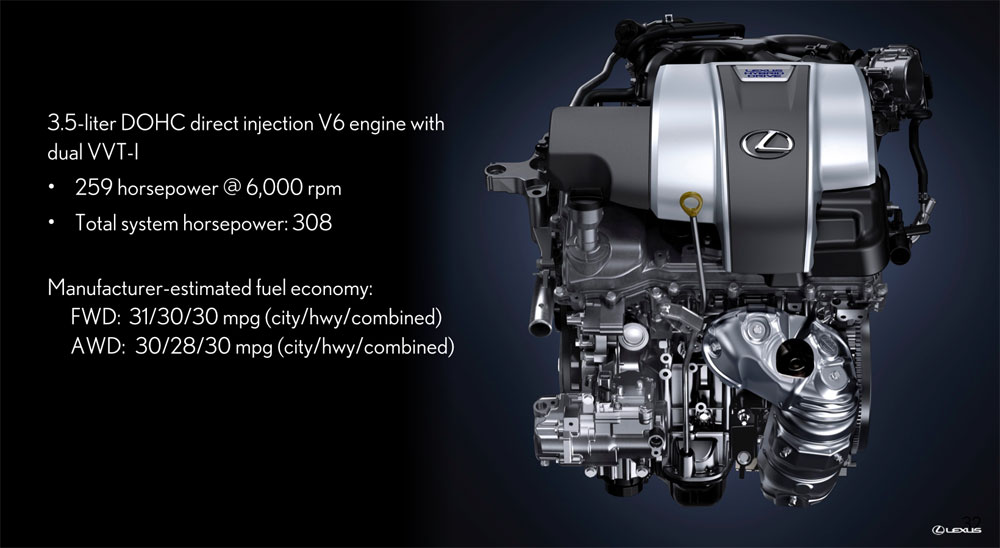
The RX 450h benefits from a power bump similar to the RX 350, as the new 2GR-FXS 3.5-liter V6 hybrid engine now generates 308 horsepower and 247 lb.-ft. torque, up from 295 horsepower and 234 lb.-ft. torque.
Lexus has estimated the RX 450h fuel economy at 30/28/30 city/highway/combined for all-wheel drive and 31/30/30 for front-wheel drive, approximately 1 mpg better than the current model.
The RX 450h AWD uses the Lexus E-Four proactive AWD system, which limits the use of all-wheel drive as necessary, switching over to full front-wheel drive when braking in order to charge the nickel-metal hydride battery.
Drive Mode Select
The RX is now equipped with a Drive Mode Select controller. There are three different driver options on the standard RX 350 and RX 450h:
- Normal: Standard mode that balances between performance and fuel efficiency;
- ECO: Emphasizes fuel efficiency by smoothing out throttle response and reducing demand on air conditioning system; and
- SPORT: Increases the responsiveness of the throttle response and tunes in the Electric Power Steering.

Interior
The front cabin of the 2016 Lexus RX is completely redesigned, and offers a cockpit design that surrounds the driver while maintaining a more open, spacious area for the front-seat passenger.
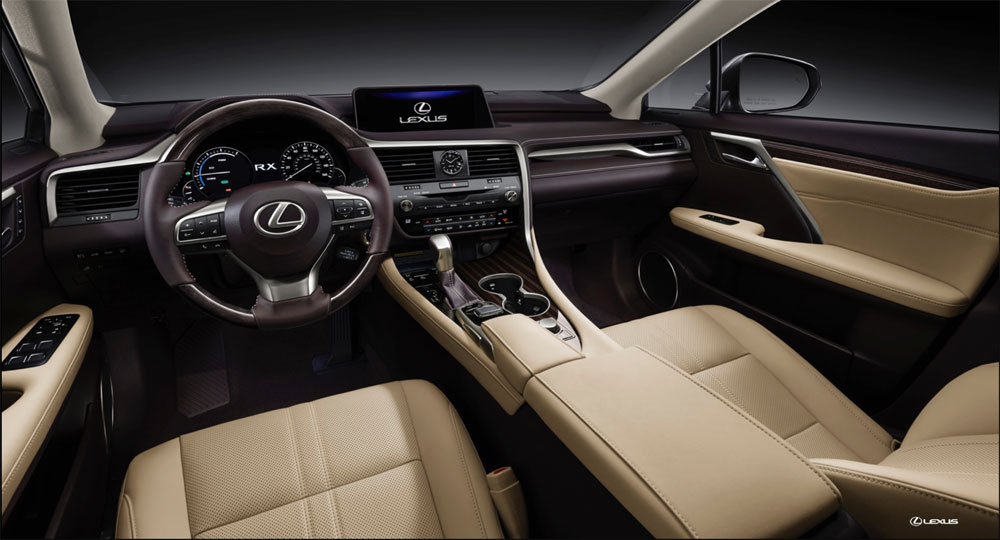
The seating position has been lowered by 0.75-inches (19mm) and the seat-side shaping has been adjusted for improved entrance and exit from the vehicle. The standard front seats are 8-way adjustable with 2-way power lumbar, while the Luxury package has 10-way adjustable front seats with 4-way power lumbar.

The rear seats are 60/40 split, and can also be configured 40/20/40 if necessary. There is a power fold/recline option available.
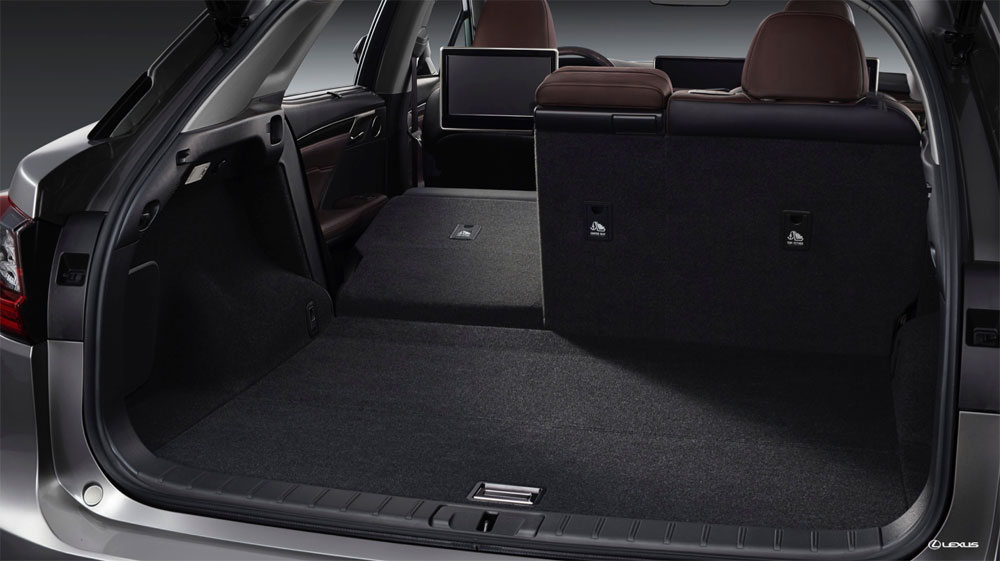
The automatic climate control has a couple features worth pointing out:
- S-FLOW control measures multiple variables to produce the requested climate, and will deliver cooling air all cabin seats until the temperature is reduced.
- Climate Concierge also works with the seat heaters/fans as a way to quickly reach the desired temperature.
There are multiple storage options inside the RX:
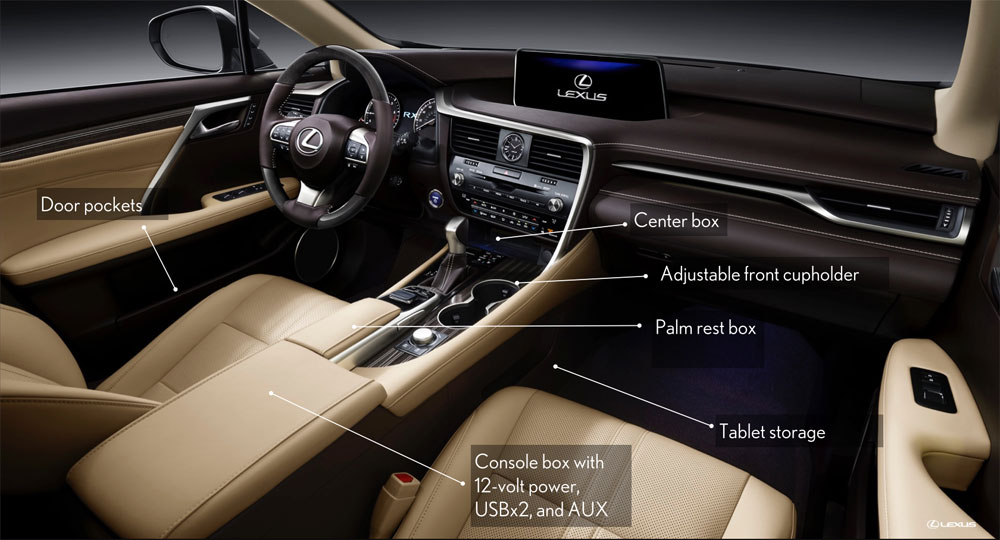
- There’s a tray with an available built-in wireless phone charger built under the center cluster.
- A tablet-sized pocket has been added to the passenger side of the center console.
- Smartphones can be stored in a compartment below the Remote Touch wrist rest.
- The depth of the front cup holder can be adjusted to accommodate a range of containers.
- The center console arm rest provides two USB and one aux connection, along with a 12-volt power supply.
Other notable features:
- The RX now has an electric parking brake, which can be automatically activated when the vehicle is put into park.
- Automatic Brake Hold, a convenience feature that locks the brakes at a stop, is now a standard feature.
Finally, it’s worth pointing out the ambient lighting inside the RX:
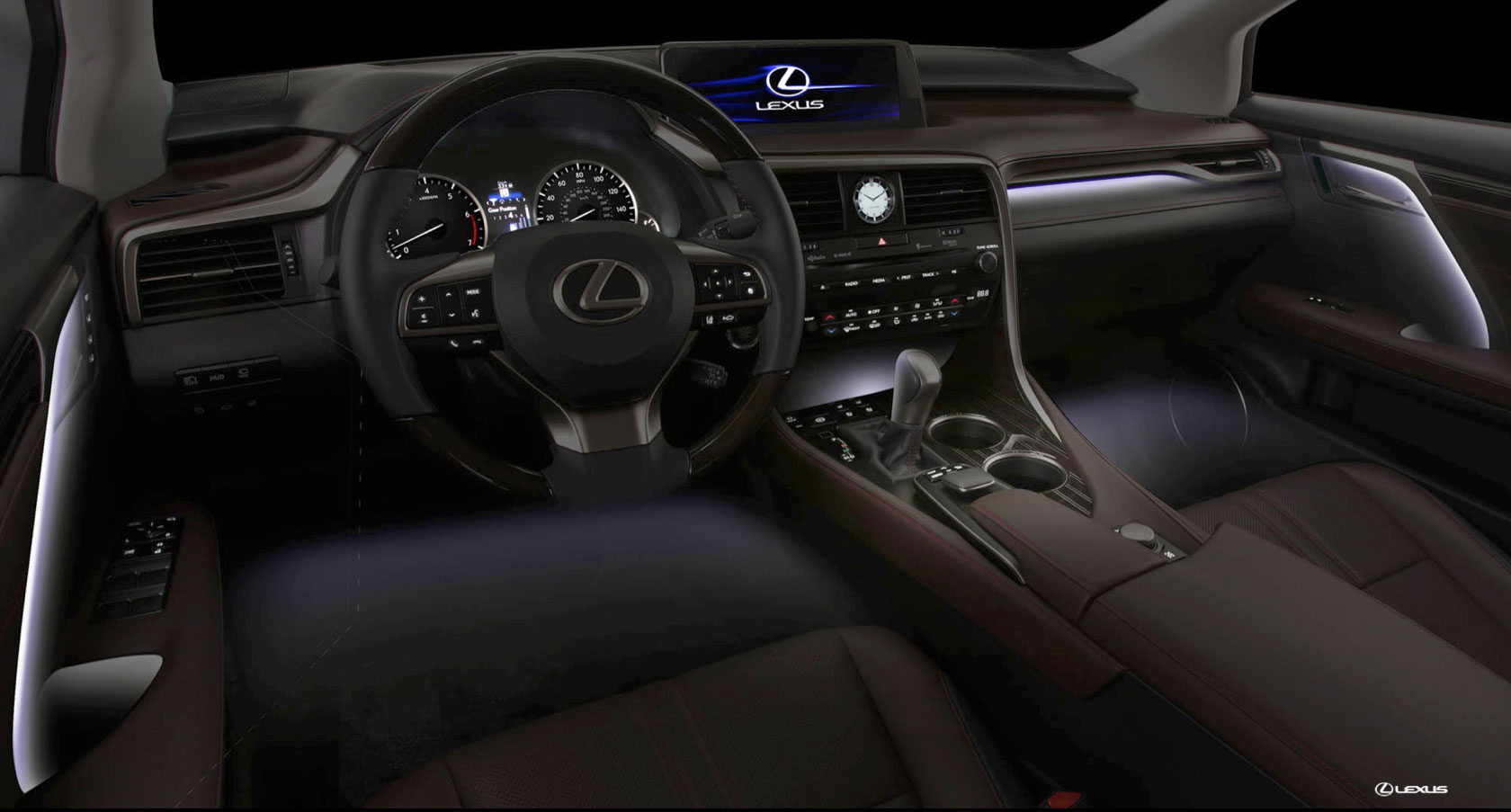
Displays and Controls
The instrument panel is a four-dial design with a 4.2-inch multi-information color display between the center clusters:
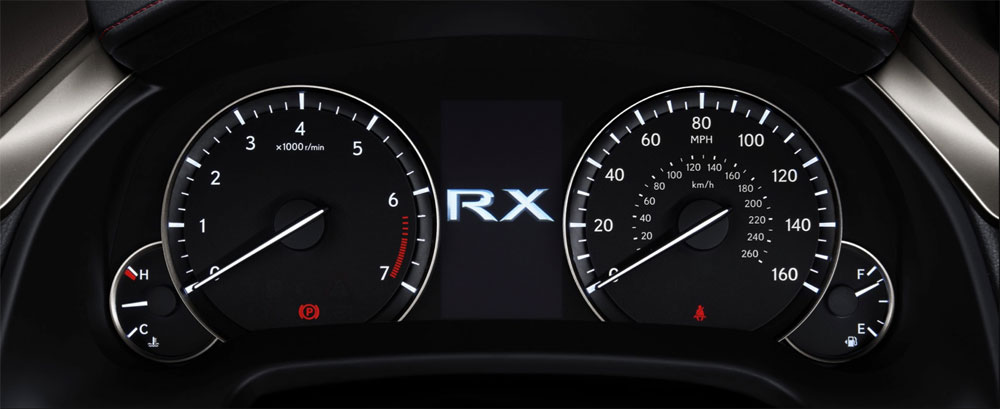
Displayed on the small screen is information relevant to the driver — trip information, navigation, cruise control status, and hands-free phone details can be cycled through using a four-way switch on the steering wheel.
Standard with the 2016 RX is an 8-inch center display with the Lexus Display Audio controller:
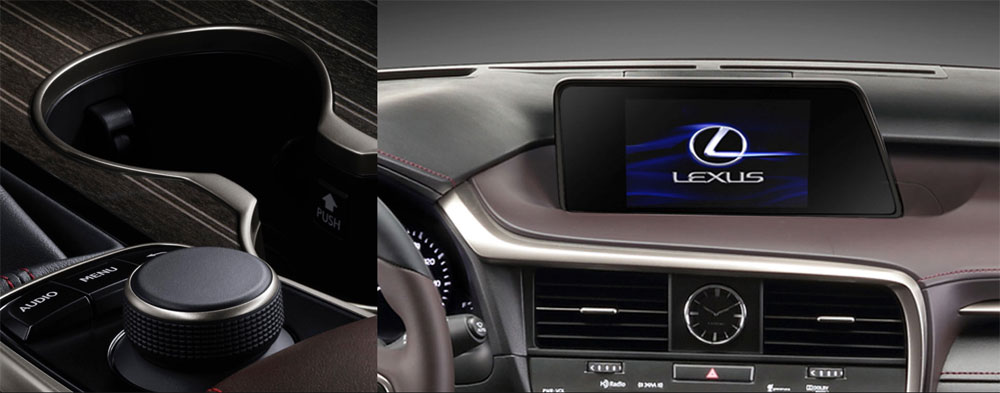
The big news is the available navigation system with a 12.3-inch display and reworked Remote Touch controller — this display can now show full-width maps, and features a new user interface with an emphasis on easier access to popular functionality.

Lexus has brought back the ENTER buttons to the side of the Remote Touch controller, and more importantly, has added a BACK button to go with the standard MAP & MENU buttons:
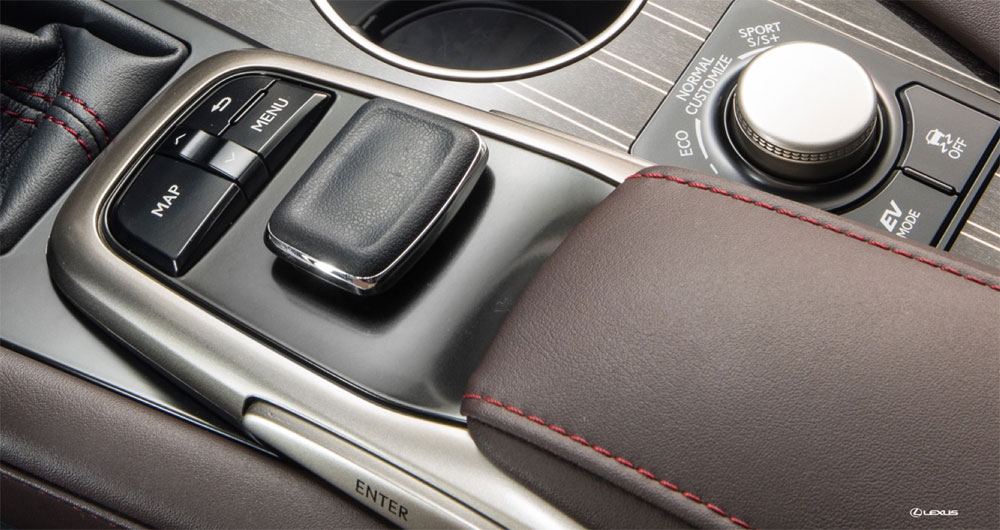
Another feature of the navigation system is a panoramic view monitor with a bird’s eye view of the RX:
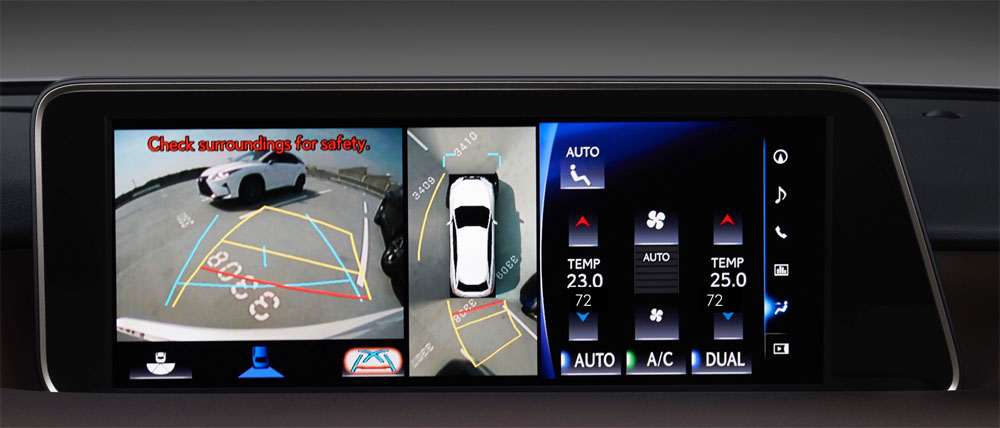
A Heads-Up Display is available as an option, and it’s massive — the glass projection measure out to 3.5 x 9.4 inch (90mm x 240mm), and can now show speed, navigation directions, cruise control status, and key driver information in full color.
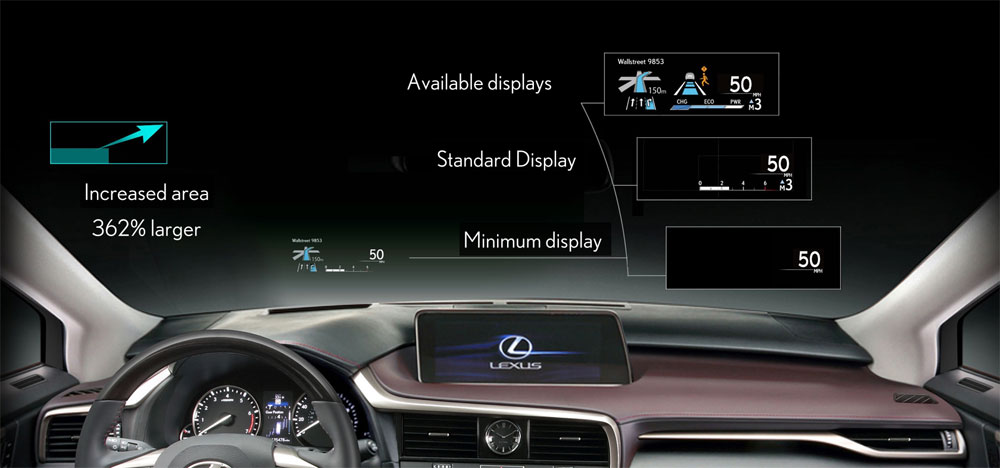
Sound Systems
The 2016 RX comes standard with a 9-speaker audio sound system with an 8-channel digital amplifier — here’s the system layout:
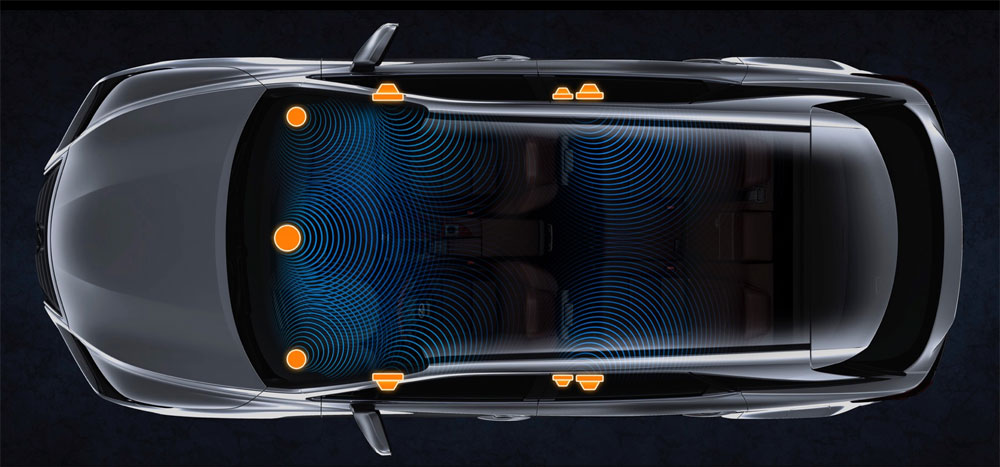
The next step up is a 12-speaker Pioneer system:
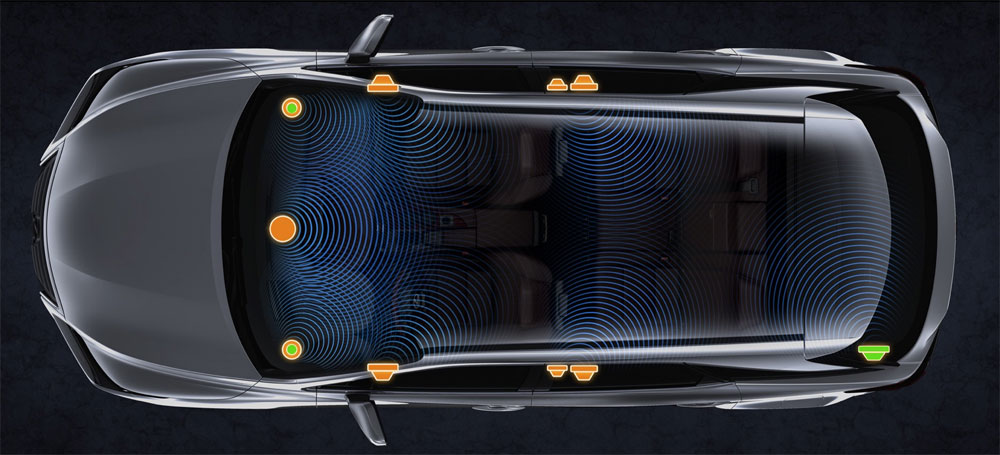
Finally, there is an available 15-speaker, 835 watt, Mark Levinson Audio System with a 12-channel amplifier:
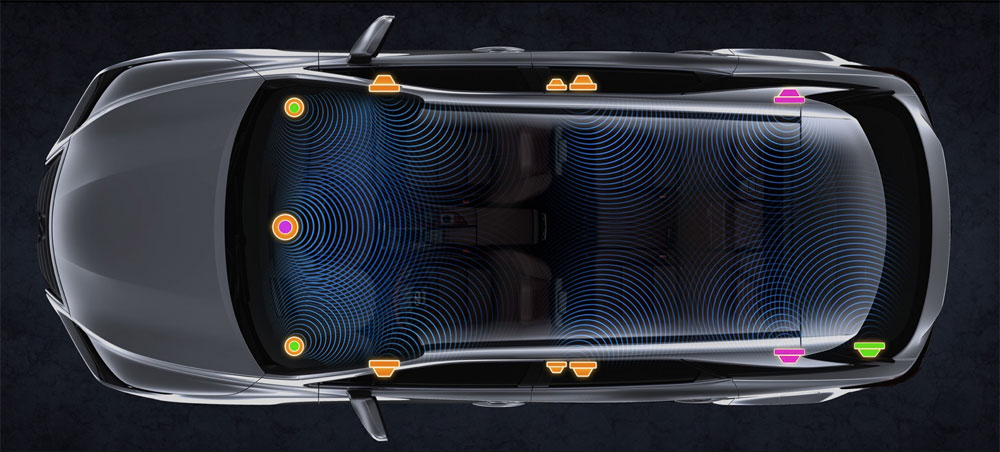
Options
A panoramic glass roof will be available with the F SPORT, Premium, or Luxury packages — the front half of the roof functions like a traditional moon roof with power tilt/slide:
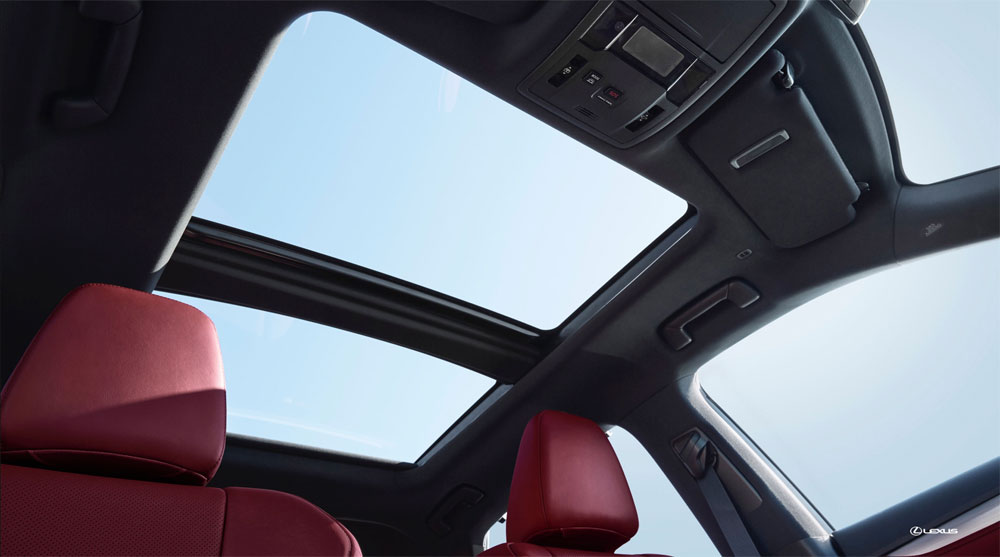
There’s also an available touch-free power back door — all that’s required is a hand or elbow over the rear Lexus logo, and the back door will open on its own:
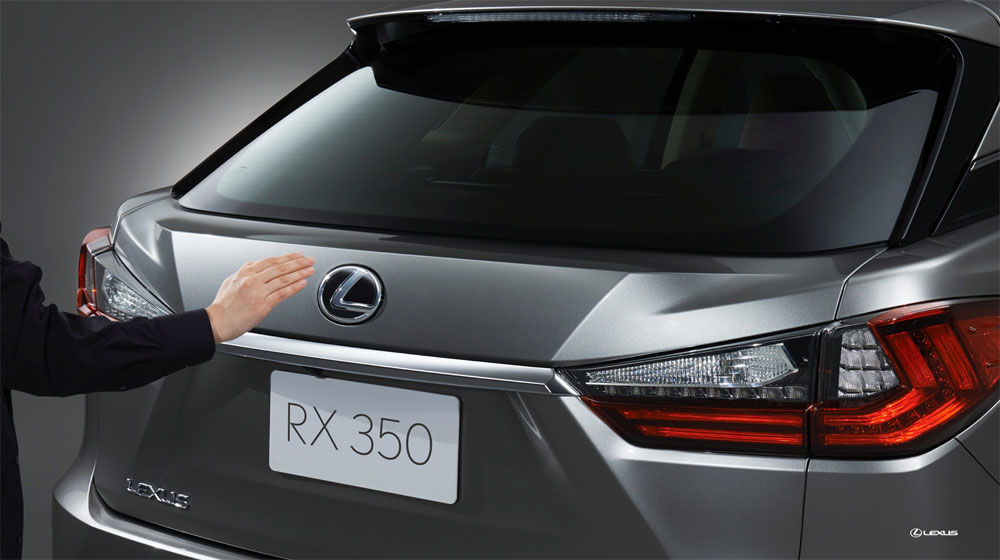
The optional rear seat entertainment system features two 11.6-inch LCD displays and an HDMI port:
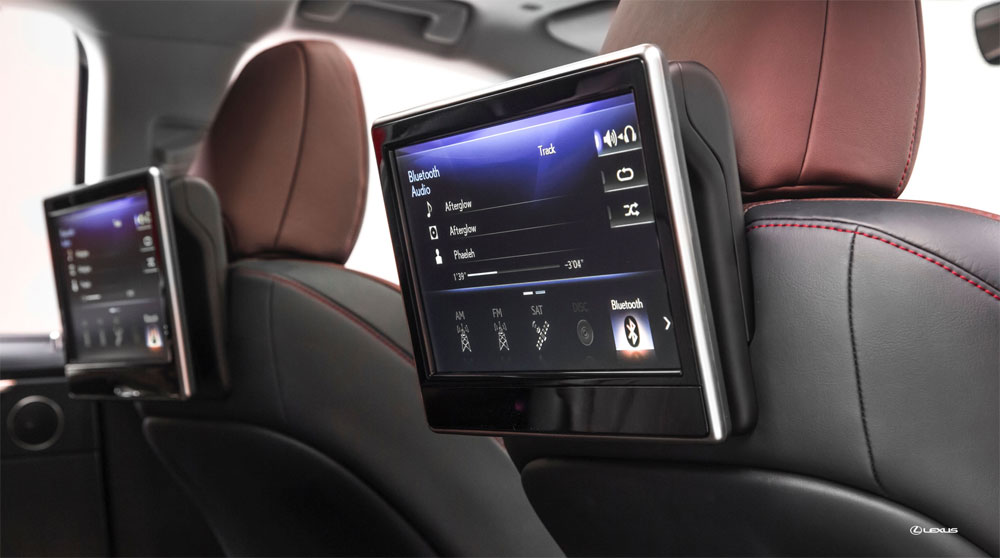
Safety Systems
The 2016 RX will be offered with the new Lexus Safety System + package, which includes all-speed dynamic radar cruise control, pre-collision system with pedestrian detection, lane departure alert with lane keeping assist, and intelligent high-beam headlights. You can read more details about the package here.
The Blind Spot Monitor with Rear Cross Traffic Alert is also available as an option — these technologies alert the driver when approaching vehicles are outside of the visible area, whether on the highway or while reversing.
Ten air bags are standard on all RX models.
Colors and Wheel Options
The RX 350 and RX 450h will be offered in nine colors: Eminent White, Nebula Gray Pearl, Silver Lining Metallic, Obsidian, Caviar, Matador Red Mica, Satin Cashmere Metallic, Autumn Shimmer, and Nightfall Mica.
For the interior, Black and Stratus Gray will be offered standard in Nuluxe. Black, Stratus Gray, Parchment, and Noble Brown will be available in natural leather with the Premium package, and semi-aniline leather in the Luxury package.
The standard interior trim is Striated Black, with the Premium package available with Expresso Walnut, Matte Bamboo, and Matte Linear Dark Mocha Wood. The Luxury package has a special trim option — Gray Sapele Wood with aluminum striping:
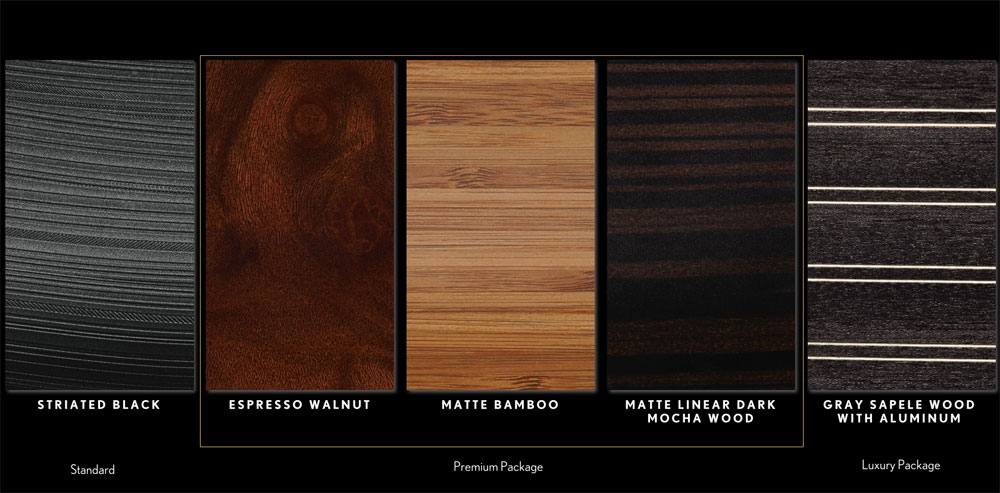
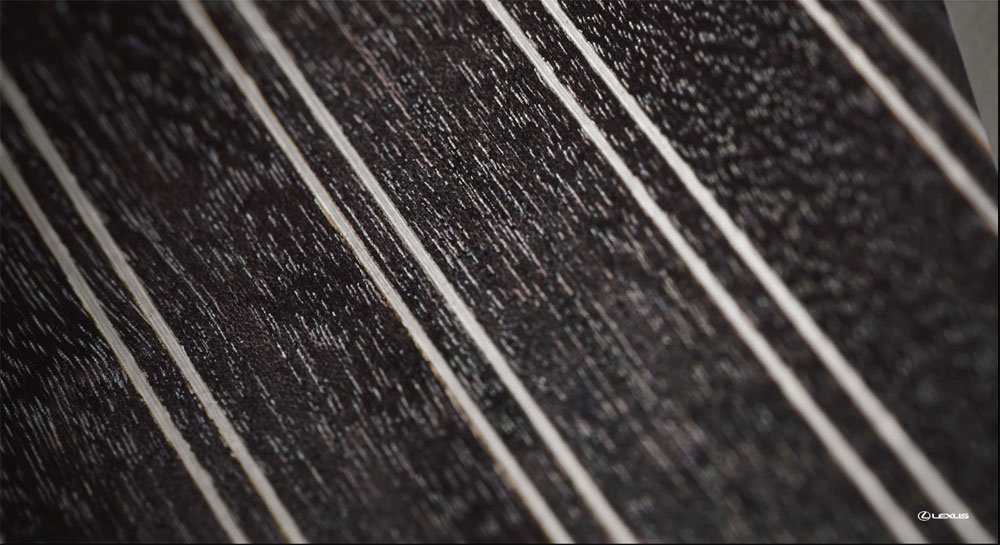
There’s an interesting production story here, in that the wood is layered on a solid sheet of aluminum and the lines are created using lasers to expose the metal underneath.
There are three wheel design available with the RX: the standard 18-inch 7-spoke alloy wheel, a 20-inch high-gloss alloy wheel, and a 20-inch super chrome alloy wheel with four available color inserts (Sonic Titanium, Obsidian, Eminent White Pearl, and Autumn Shimmer) — here are examples of each:

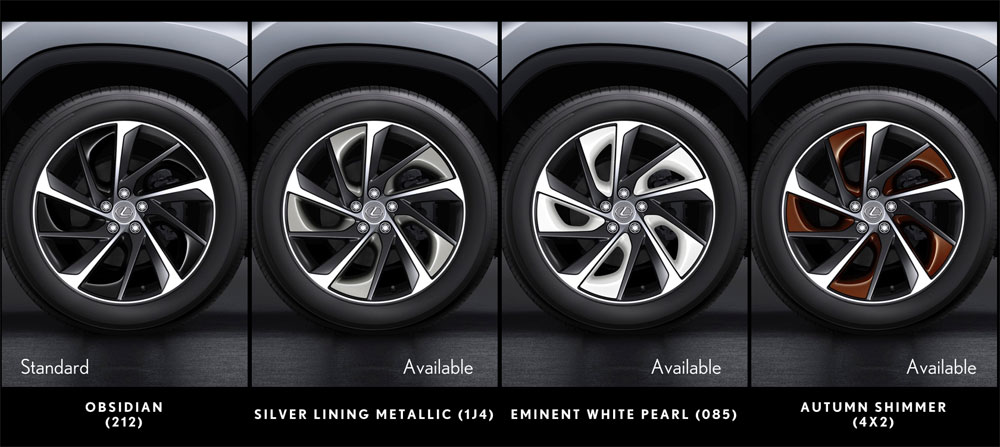
The Lexus RX will also be the first crossover to be offered with the Michelin PREMIER LTX tires, which features a new tread technology that reveals hidden grooves that improve grip as the tire wears. The PREMIER LTX will be offered in both the standard 235/65R18 and optional 235/55R20 sizes.
Lexus RX F SPORT
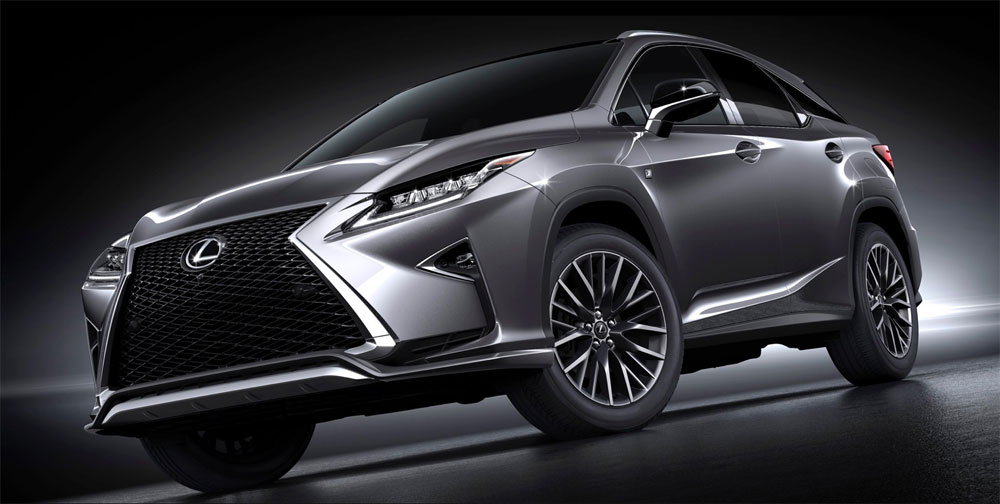
For the first time in North America, the RX 450h will join the RX 350 in offering the F SPORT package. With both models, it’s a comprehensive upgrade over the standard crossover.
Most importantly, the RX F SPORT features an Adaptive Variable Suspension (AVS), which controls the shock absorber damping force on all four wheels. This allows for on-the-fly adjustments to the ride comfort and stability depending on driving conditions.
The addition of AVS also brings three new options to the Drive Mode Select:
- SPORT S mode adjusts throttle mapping for a quicker quicker drivetrain response.
- SPORT S+ mode combines SPORT S mode with sharper power steering and a stiffer suspension setting.
- New to Lexus is a CUSTOMIZE mode, where the driver can personalize the driving experience. Here is a convenient chart showing the various configurations:
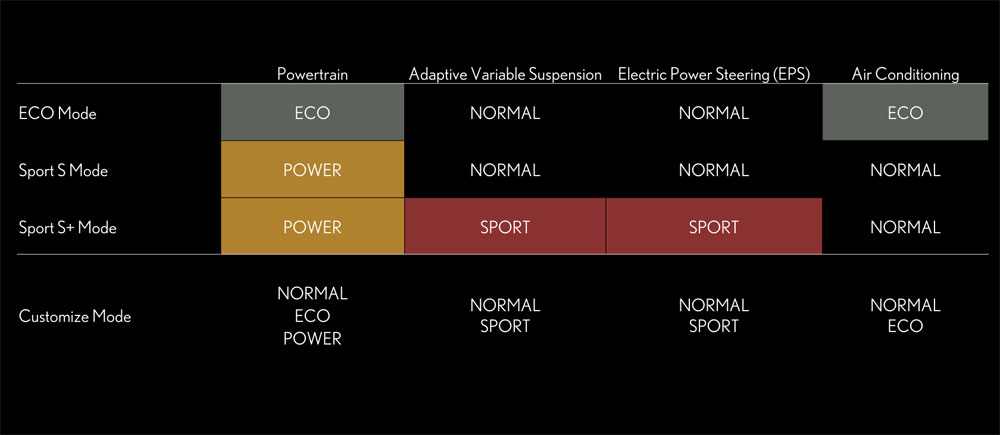
The RX F SPORT is equipped with an intake sound generator that pipes engine sound into the cabin during acceleration:

Visually, there are five changes to the exterior: the mesh front grille and lower spoiler, blacked-out side mirrors, some additional chrome trim on the rear bumper, F SPORT badging, and an 20-spoke 20-inch wheel design are all exclusive to the F SPORT model.
RX F SPORT models will be offered in seven exterior colors: Ultra White, Nebula Gray Pearl, Silver Lining Metallic, Obsidian, Caviar, Matador Red Mica, and Nightfall Mica.
Inside, the F SPORT package has a number of upgrades, starting with paddle shifters for manual control of the eight-speed transmission. There’s also a perforated leather-trimmed steering wheel and shift lever:
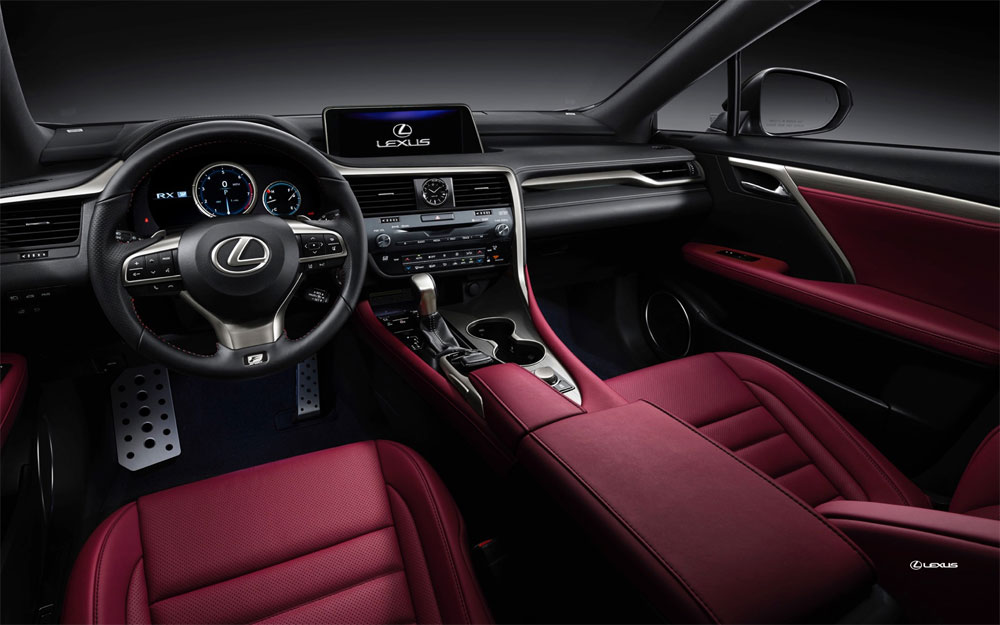
The front seats are more firmly bolstered to give the driver and front passenger a stronger grip in their seats:

The instrument panel is more performance focused with a design similar to other Lexus F SPORT models — the difference here is that the central dial does not move side-to-side:
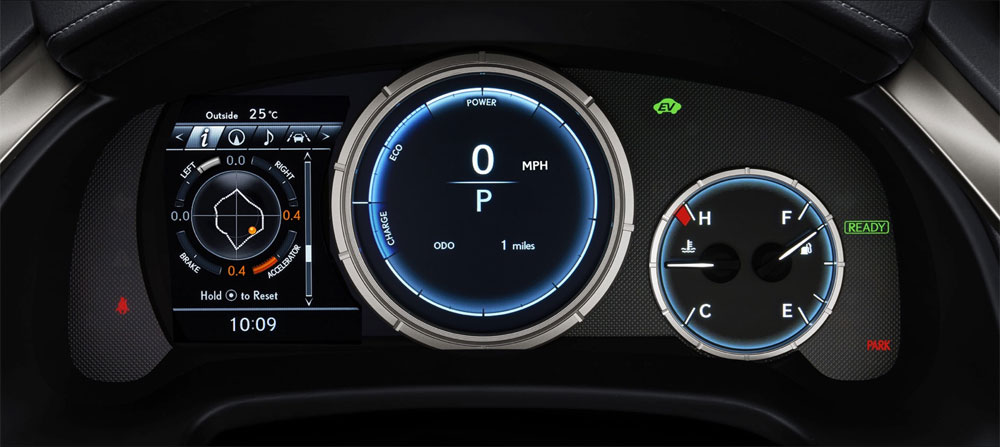
Another addition to the instrument panel is a G sensor for measuring the vehicle’s lateral and longitudinal G forces.
The RX F SPORT will come standard with leather in three available colors: Black, Stratus Gray, and the F SPORT exclusive Rioja Red. Aluminum is the only trim option.
This ends my technical overview of the 2016 RX crossover — please check back next week for my personal impressions of the RX 350, RX 350 F SPORT, RX 450h, and RX 450h F SPORT. For premium members, I’ve just posted a short video in the forums. My thanks to Lexus for inviting me to this event.


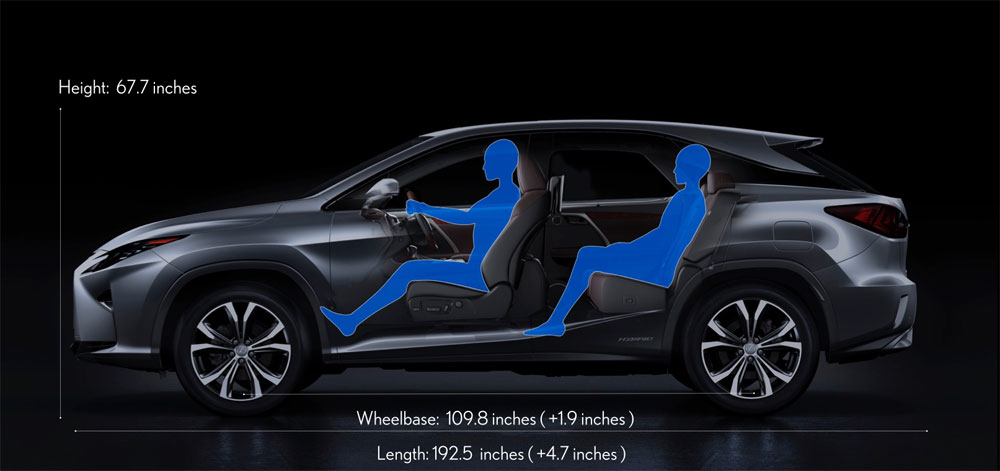
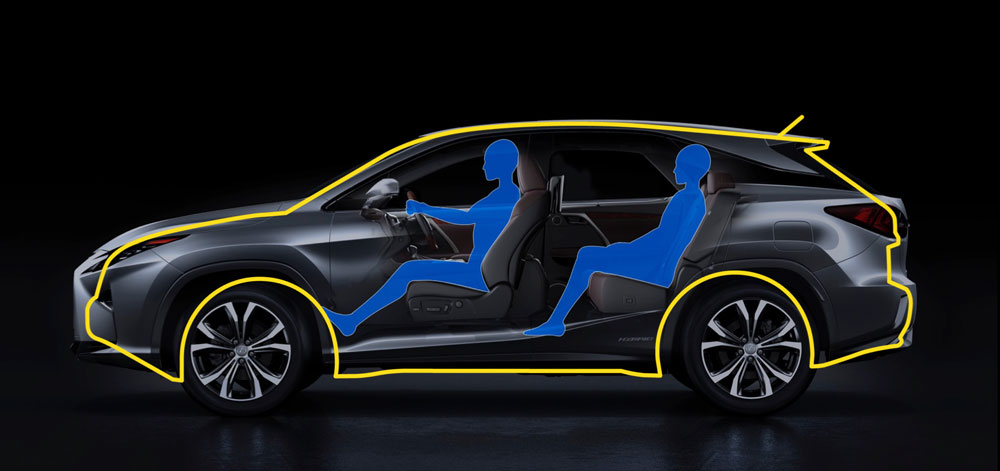
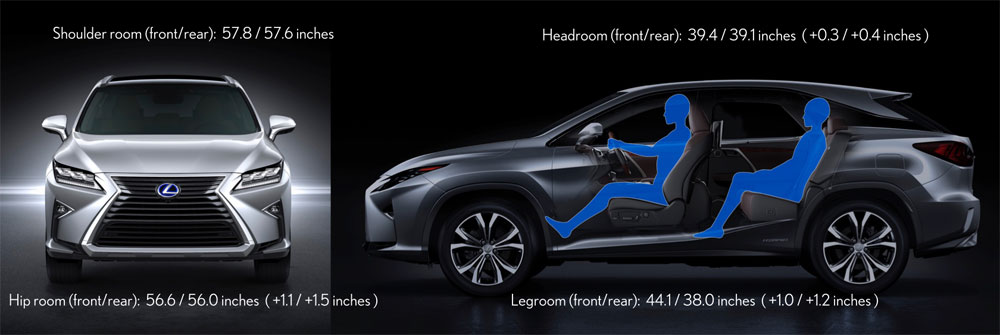

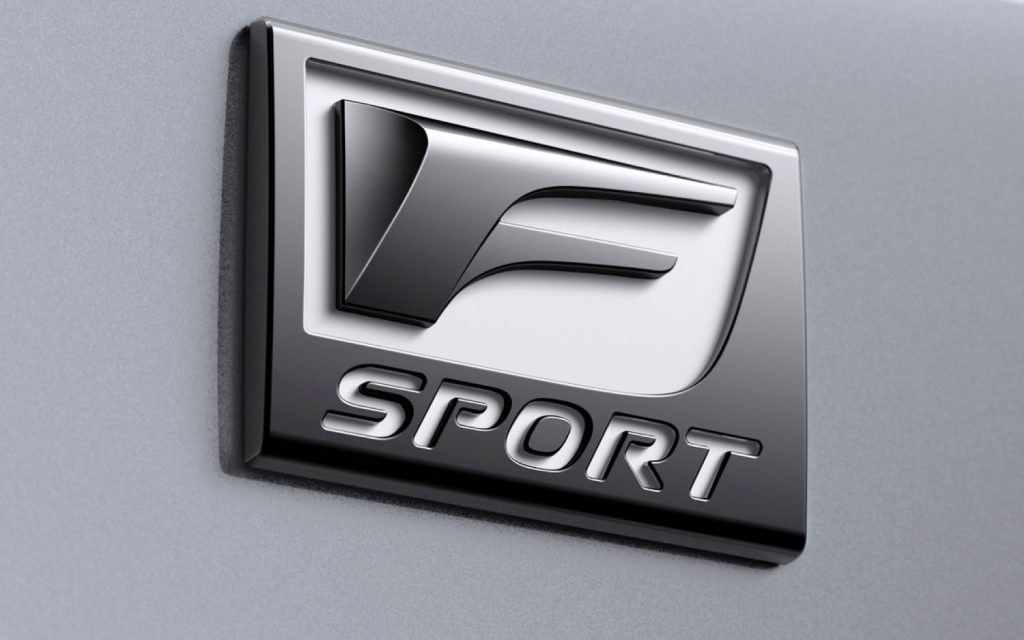
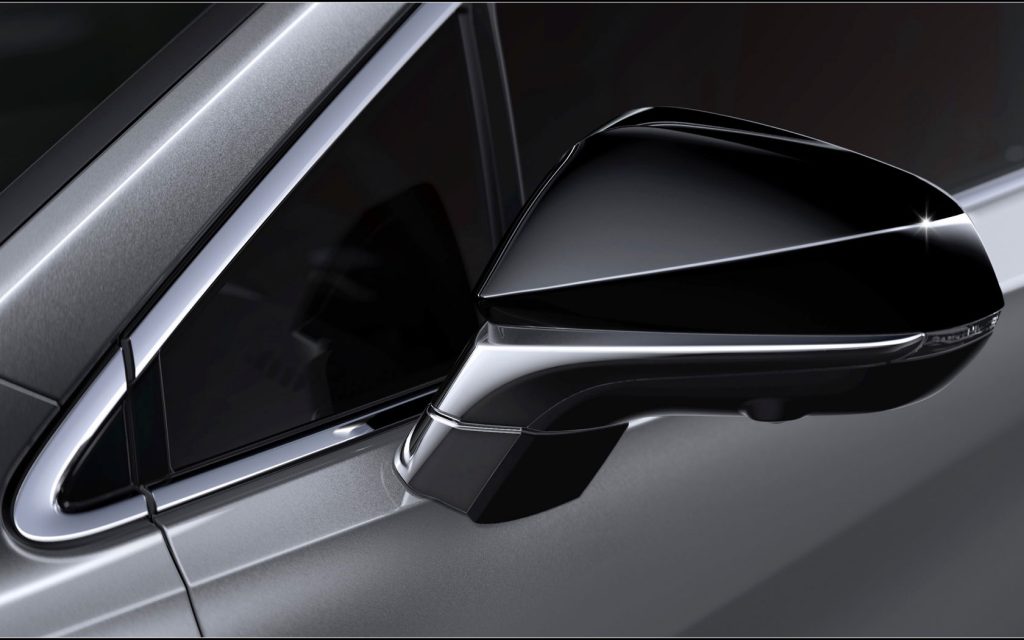
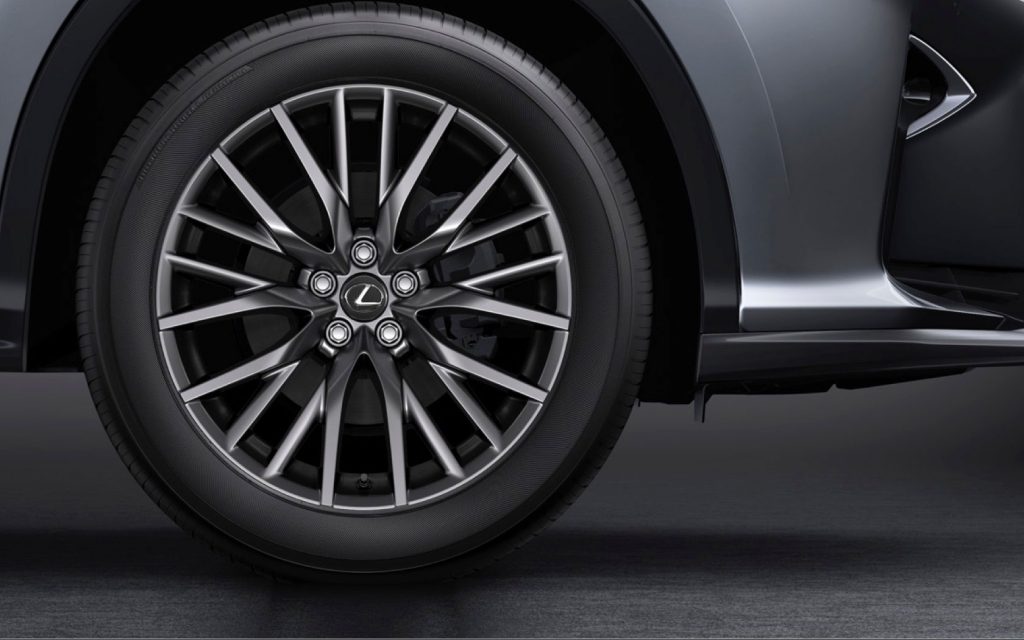
Comments